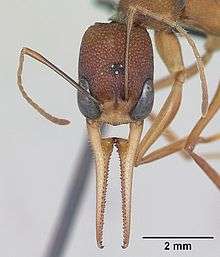Harpegnathos
Harpegnathos is a small ponerine genus of ants found in South and Southeast Asia. They are notable for their jumping ability, complex colony structure, and large to very large workers easily identifiable by their long mandibles and large eyes.[3]
| Harpegnathos | |
|---|---|
 | |
| Worker H. saltator killing a queen in an inter-colony conflict | |
| Scientific classification | |
| Kingdom: | Animalia |
| Phylum: | Arthropoda |
| Class: | Insecta |
| Order: | Hymenoptera |
| Family: | Formicidae |
| Tribe: | Ponerini |
| Genus: | Harpegnathos Jerdon, 1851 |
| Type species | |
| Harpegnathos saltator[1] Jerdon, 1851 | |
| Diversity[2] | |
| 7 species | |
| Synonyms | |
|
Drepanognathus Smith, F., 1858 | |
Taxonomy

The genus was established by Thomas C. Jerdon in 1851 to house the single species Harpegnathos saltator, found in India.[4] Believing that the name was unavailable due to homonymy, Smith (1858)[5] incorrectly erected the unnecessary replacement name Drepanognathus (now a synonym of Harpegnathos). For some time, both names were used in publications by other authors until the original name was restored.[3] The most recent species was described in 1963, making the total number of Harpegnathos species seven, with an additional four described subspecies.[2] The genus is closely related to the other genera in its tribe, Ponerini, and is probably a sister to all Ponerini.[3]
Colony structure
Harpegnathos has a complex and different colony structure compared to other genera. In the beginning, young winged queens fly out from their natal colony, mate with foreign males and start new colonies independently. What differs from other ants is that, once the short-lived founding queen dies, several daughter workers replace her as reproductives in the colony. Characteristic of several ponerine species, workers can mate (almost always with foreign males) and store sperm in the spermatheca.[3]
In H. saltator, many young workers inbreed with males from the same colony (their brothers). They fight to establish a dominance hierarchy, and a few high-ranking workers become reproductives and lay eggs, so-called gamergates. Every year, new winged queens are reared, and they disperse and start the process again. The combination of queen and gamergate reproduction results in an increased lifespan of colonies, in theory making them immortal.[3][6]
Species
- Harpegnathos empesoi Chapman, 1963
- Harpegnathos hobbyi Donisthorpe, 1937
- Harpegnathos macgregori Wheeler & Chapman, 1925
- Harpegnathos medioniger Donisthorpe, 1942
- Harpegnathos pallipes (Smith, 1858)
- Harpegnathos saltator Jerdon, 1851
- Harpegnathos venator (Smith, 1858)
References
- "Genus: Harpegnathos". antweb.org. AntWeb. Retrieved 13 October 2013.
- Bolton, B. (2015). "Harpegnathos". AntCat. Retrieved 5 January 2015.
- Schmidt, C. A; Shattuck, S. O. (2014). "The Higher Classification of the Ant Subfamily Ponerinae (Hymenoptera: Formicidae), with a Review of Ponerine Ecology and Behavior". Zootaxa. 3817 (1): 1–242. doi:10.11646/zootaxa.3817.1.1. PMID 24943802.
- Jerdon, T. C. (1851). "A catalogue of the species of ants found in Southern India". Madras Journal of Literature and Science. 17: 103–127.
- Smith, F. (1858). Catalogue of hymenopterous insects in the collection of the British Museum. Part VI. Formicidae. London: British Museum, 216 pp.
- Peeters, C.; Liebig, J.; Hölldobler, B. (2000). "Sexual reproduction by both queens and workers in the ponerine ant Harpegnathos saltator". Insectes Sociaux. 47 (4): 325–332. doi:10.1007/PL00001724.
External links
